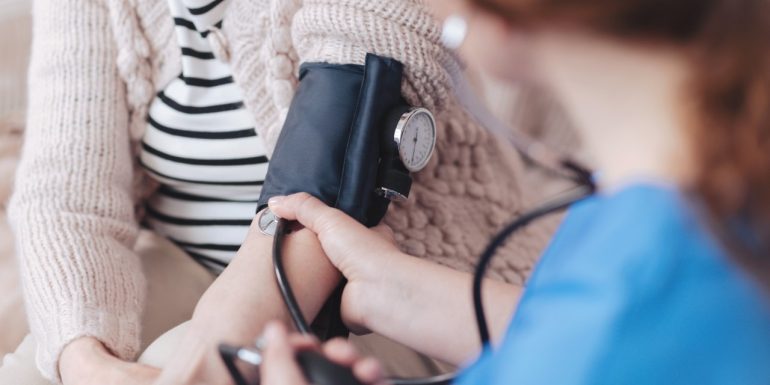
Is my blood pressure normal?
Normal blood pressure is essential to our health. But what is considered normal blood pressure? Does it differ by age and gender? Blood pressure explained simply and blood pressure levels at a glance.
Our heart pumps blood through our body with every heartbeat – around 10,000 litres daily. The blood supplies organs and tissues with nutrients and oxygen. But what is blood pressure?
A certain amount of pressure, generated inside the blood vessels, is required for the blood to be able to flow. Blood pressure is regulated by the interplay of heartbeat, blood volume, blood vessels and other factors. Blood pressure is measured using two numbers.
Blood pressure levels: systolic and diastolic blood pressure
When measuring blood pressure, two numbers are always given, e.g. 120 over 80 mmHg (millimetres of mercury). What do these two numbers mean?
- Systolic blood pressure: the upper reading describes the pressure of the vessels at the moment when the heart muscle contracts, thus pumping oxygen-rich blood into the vessels.
- Diastolic blood pressure: the lower reading shows the residual pressure in the relaxation phase when the heart relaxes and refills with blood.
Both numbers – the systolic and the diastolic blood pressure – serve as an indication of how our blood vessels are doing. Often undetected, high blood pressure increases the risk of illnesses like heart attack and stroke and harms the eyes and kidneys. Low blood pressure rarely poses a problem for blood vessels, as long as it isn’t accompanied by complaints like dizziness or headaches.
Once you’ve reached the age of 18, your blood pressure should be checked at least once every three years, and after 40, once a year – and even more frequently in the case of obesity or other risk factors for high blood pressure. But what is normal blood pressure?
Normal blood pressure
Healthy blood pressure should remain within a standard range but is subject to natural fluctuations throughout the course of the day: generally speaking, it rises in the morning just after waking up, before falling slightly around midday and peaking again between 4 p.m. and 6 p.m. Physical exertion, stress, anxiety and pain also increase blood pressure, whereas the latter drops after meals and while we are asleep.
What blood pressure is normal at what age?
Your blood pressure changes over the course of your life. Children have lower blood pressure than adults. In adults, the risk of high blood pressure increases with age. Among the over-60s, every one in two people is affected by it. In women, the risk increases on starting the menopause. The blood pressure table shows which blood pressure ranges are ideal, normal or too high.
Blood pressure table
|
|
|
|
|---|---|---|
|
|
|
|
|
|
|
|
|
|
|
|
|
|
|
|
|
|
|
|
|
|
|
|
Upper/systolic reading(mmHg)
Lower/diastolic reading (mmHg)
Ideal blood pressure
Below 120
Below 80
Normal blood pressure
120–129
80–84
High normal blood pressure
130–139
85–89
Slight hypertension (level 1)
140–159
90–99
Medium hypertension (level 2)
160–179
100–109
Severe hypertension (level 3)
180 or over
110 or over
Ideal blood pressure for adults is below 120/80 mmHg. Blood pressure readings of up to 130/85 mmHg are regarded as normal, below 140/90 as high-normal – but this may require treatment where there are existing risk factors like diabetes. Blood pressure levels in excess of 140/90 mmHg are generally critical to health and must be treated.
Normal blood pressure, differences between women/men
The medical guidelines for blood pressure thresholds apply equally to adults of all age groups and both genders. The levels in the blood pressure table above apply to both men and women.
However, the recommended therapeutic objective for medical treatment may vary depending on the patient’s age and secondary health conditions. For instance, a doctor will set a lower target blood pressure for a 40-year-old person with high blood pressure and diabetes (below 130/80) than for an 80-year-old person without any additional cardiovascular risks (e.g. below 140/90).
How do I check whether my blood pressure is normal?
When should you measure your blood pressure?
Ideally, always take it at the same time of day, preferably in the morning before taking any blood pressure-lowering medication and after a five-minute rest.
How do you measure your blood pressure?
You need a digital or manual blood pressure monitor, preferably one for your upper arm. If you don’t have one at home, you can also get your blood pressure measured in a pharmacy.
What side should you measure blood pressure on?
Perform the first measurement on both arms; from then on, always measure the side with the higher readings.
When should you not use your arm to measure blood pressure?
For example, if you have a wound, are affected by paralysis, have lymphoedema or if you have had surgery on lymph nodes in that area.
- Position the cuff of your blood pressure monitor as tightly as possible on your bare upper arm, about 1 to 2 cm above the bend of your elbow. Ensure that rolled-up sleeves don’t press tightly against your arm. If you are using a wrist blood pressure device: raise the height of your forearm to heart level using a cushion.
- Relax your arm and place it unstretched and with your palm facing upwards onto an armrest or a table. The cuff must be at heart level during measurement.
- Relax for one minute before the measurement: sit up straight in a comfortable position.
- Start the measurement. Try not to move during this time, don’t speak and don’t touch the device.
- Once the blood pressure measurement has finished, the readings of the upper, systolic and lower, diastolic blood pressure appear on the display (for example: 125/85 mmHg).
The best thing to do is enter the readings on a blood pressure pass. You can use the one provided by the Swiss Heart Foundation. Note any unusual circumstances or complaints that might have an effect on the readings. Take your notes to your next medical check-up.
Normal blood pressure is a question of genes – but also one of lifestyle. Keep your blood vessels young with a balanced, low-salt diet, moderate consumption of alcohol, regular exercise and plenty of rest. In other words, anything that benefits our health generally. Prevention is better than cure in any case.

The expert provided the editorial team with advice and input for this article. Julia Pieh (doctorate in pharmacy and toxicology, pharmacist, naturopath) works in the Helsana Health Consultation Service. She helps customers on issues to do with health promotion.


Newsletter
Find out more about current health issues every month and get all the information you need about our attractive offers from all Helsana Group companies * delivered by e-mail to read whenever it suits you. Our newsletter is free of charge and you can sign up here:
- Ms
- Mr
We did not receive your information. Please try again later.
* The Helsana Group comprises Helsana Insurance Company Ltd, Helsana Supplementary Insurances Ltd and Helsana Accidents Ltd.